Tooth loss not only hinders the normal function of your teeth but also affects your appearance. Patients often opt for artificial replacements like dentures to restore both aesthetics and tooth functionality. One such option is the removable partial denture, which is designed to replace one or a few missing teeth. Unlike fixed alternatives, this type of denture isn’t permanently affixed to the mouth.
Removable partial dentures rely on the soft and bony tissues in your oral cavity to maintain their position and provide support. This means there’s no need to alter or remove adjacent teeth to secure a prosthesis in place. Instead, a wire structure, known as a clasp, is attached to the neighboring tooth adjacent to the edentulous area (the area where teeth are missing). This clasp serves as the primary anchor for the removable partial denture.
Furthermore, additional support and retention for the denture can be achieved through nearby soft tissue structures, bony undercuts, or the use of elements like magnets, springs, and clips.1Campbell, S. D., Cooper, L., Craddock, H., Hyde, T. P., Nattress, B., Pavitt, S. H., & Seymour, D. W. (2017). Removable partial dentures: The clinical need for innovation. The Journal of Prosthetic Dentistry, 118(3), 273–280. https://doi.org/10.1016/j.prosdent.2017.01.008. Patients can easily place and remove the denture by themselves by following their dentist’s instructions.
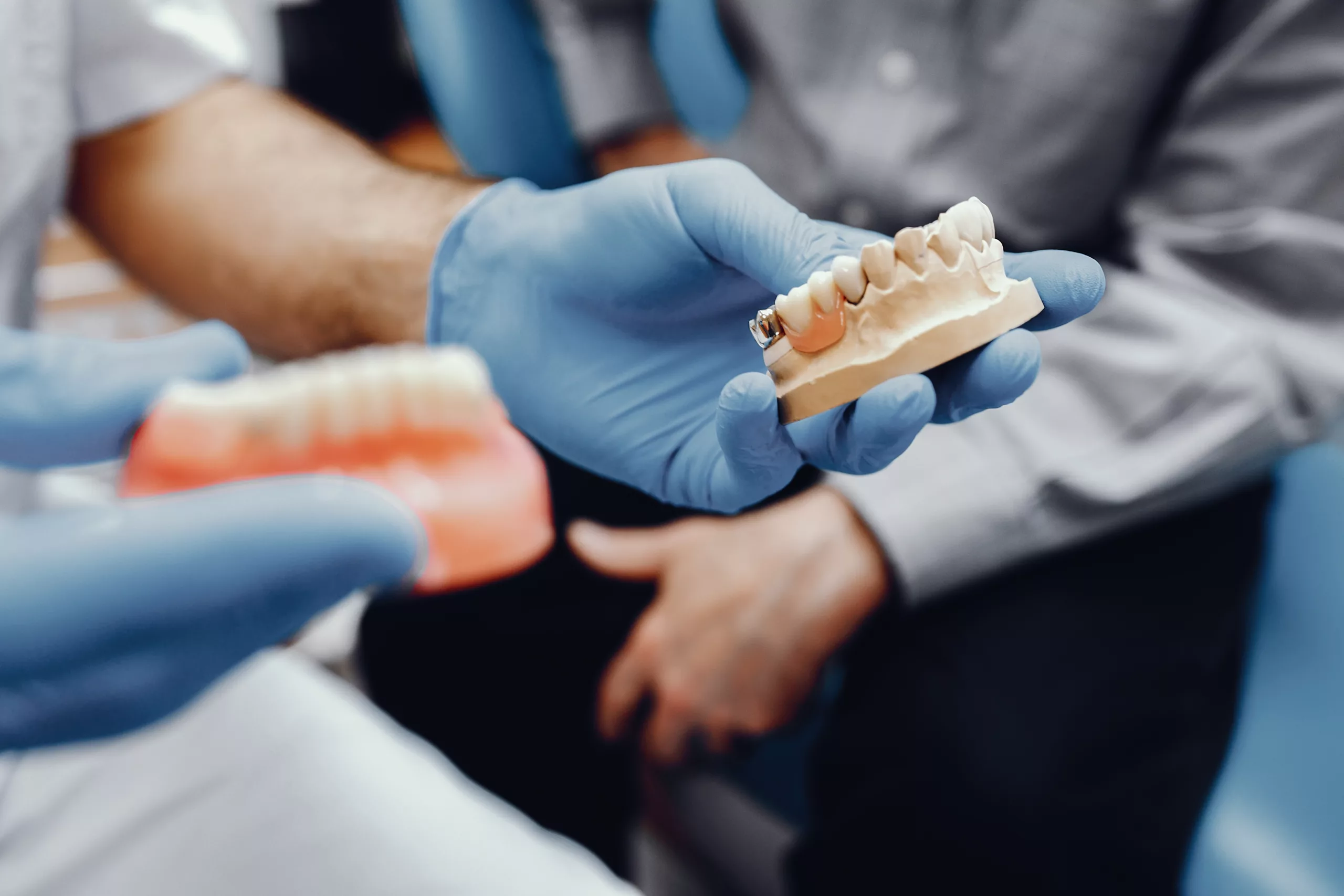
What is a Removal Partial Denture?
A removable partial denture is a dental prosthesis used to replace one or more missing teeth, and patients can reinsert and remove it without the dentist’s assistance. They are not intended to replace the entire set of teeth. To stay in the oral cavity, this denture requires support from adjacent teeth and underlying hard and soft tissues2Davenport, J. C., Basker, R. M., Heath, J. R., Ralph, J. P., & Glantz, P. O. (2000). The removable partial denture equation. British Dental Journal, 189(8), 414–424. https://doi.org/10.1038/sj.bdj.4800787
A removable partial denture has an acrylic or metal base over which artificial teeth made of porcelain or acrylic resins are fixed. This denture is inserted in the edentulous area, enhancing both aesthetics and functionality. Notably, it plays a pivotal role in preventing potential complications resulting from tooth loss.
One common complication involves the adjacent teeth leaning into the space, essentially decreasing the gap.3Craddock HL, Youngson CC, Manogue M, Blance A. Occlusal changes following posterior tooth loss in adults. Part 2. Clinical parameters associated with teeth movement adjacent to the posterior tooth loss site. J Prosthodont. 2007 Nov-Dec;16(6):495-501. doi: 10.1111/j.1532-849X.2007.00223.x. Epub 2007 Aug 2. PMID: 17672834. This tooth movement disrupts the alignment with their adjacent and opposing teeth, causing malocclusion. As a result, patients may encounter both functional and aesthetic challenges stemming from this dental misalignment.
Types of Removable Partial Dentures
Different types of removable partial dentures are based on differences in shape and composition. Following are the major types of removable partial dentures
Cast Metal Partial Denture
This commonly used partial denture has a metallic base formed through casting4Scher E. (1980). ‘Removable partial denture design.’ British Dental Journal, 149(8), 223. https://doi.org/10.1038/sj.bdj.4804496. Casting is the process in which a high temperature-responding wax pattern is transformed into a metal structure. These dentures have a life of almost eight to ten years.
Sometimes, a thin layer of gum-resembling pink acrylics is applied to cover the metallic base to enhance the aesthetics. Patients secure them in the oral cavity using a wire clasp attached to the natural teeth adjacent to the edentulous space. Although pricier than acrylic alternatives, these dentures can be a permanent solution for replacing one or more missing teeth.
Acrylic Partial Denture
Acrylic partial dentures have a pink acrylic base with artificial teeth placed over it. The acrylic base gives a bulky look to the denture and sometimes causes discomfort to the patients. These dentures are also tied with the help of a clasp or springs. The use of acrylic in the whole framework lowers its cost price significantly, but the temperature sensitivity and poor quality of acrylics made them temporary prostheses to replace missing teeth5Jones, J. D., Turkyilmaz, I., & Garcia, L. T. (2010). Removable partial dentures–treatment now and for the future. Texas Dental Journal, 127(4), 365–372..
However, in clinical practice, many acrylic dentures are manufactured compared to metal framework dentures. A significant portion of these dentures serve as permanent solutions.6Walmsley A D. Acrylic partial dentures. Dent Update 2003; 30: 424-429. Additionally, many patients may prefer an acrylic removable partial denture (ARPD) due to its cost-effectiveness.
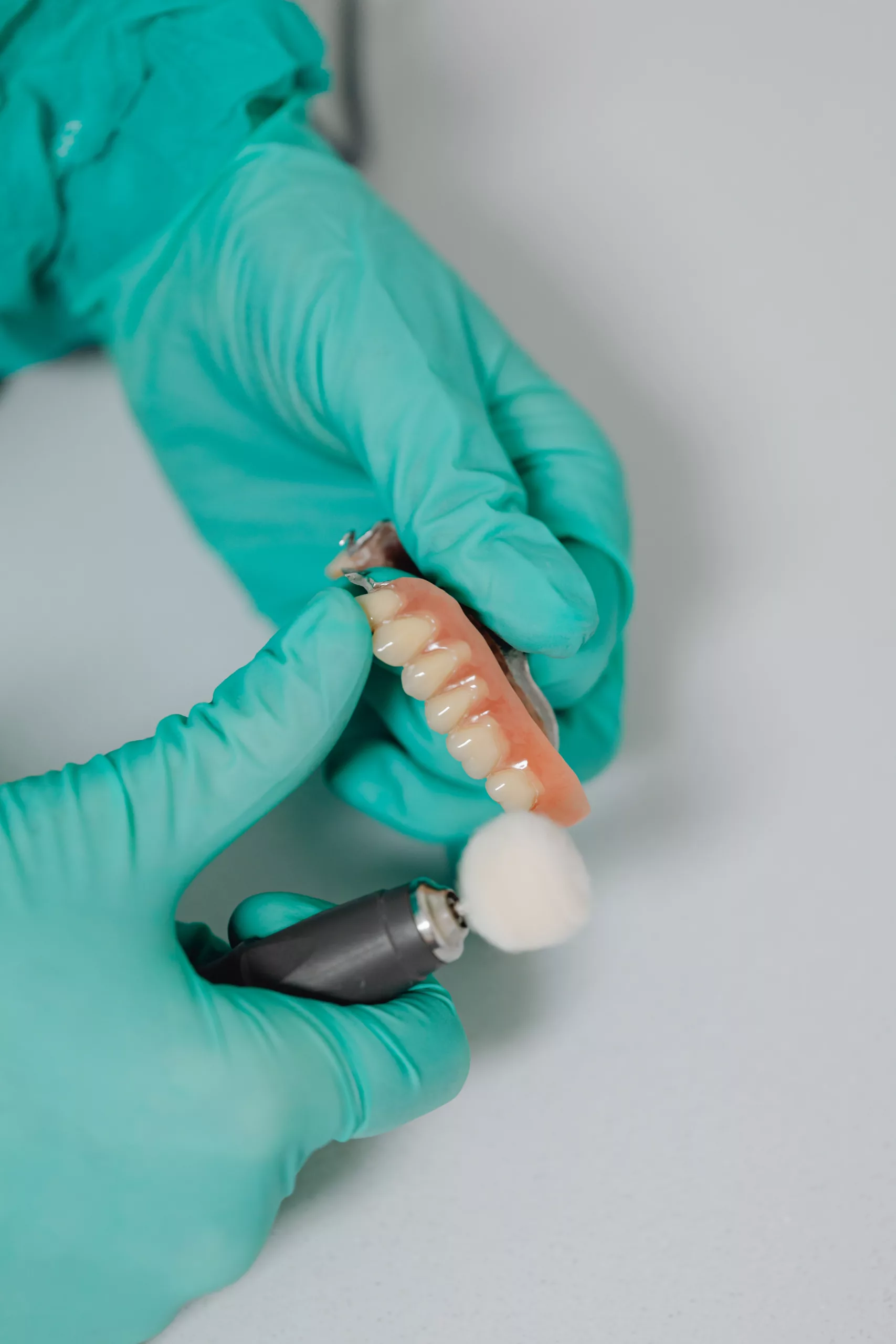
Flexible Partial Denture
In some cases, patients are allergic to acrylics and metal frameworks. So, giving them metal or acrylic dentures will result in a hypersensitivity reaction. To overcome this problem, dentists can use flexible partial dentures in such cases. Dentists craft these dentures from aesthetically pleasing plastic material that offers comfort to the patients. Although making them look like natural structures, this flexible denture is quite expensive than the metal type and has a short life due to the thin plastic material.
Components of Removable Partial Denture
All definitive removable partial dentures (RPDs) consist of a standard set of components, each serving specific functions to ensure the RPD functions effectively. These components include:
- Major Connector: This component is a substantial part of the RPD framework that connects different sections of the prosthesis. It provides stability and strength to the RPD.
- Minor Connectors: These smaller connectors link various elements within the RPD framework, aiding in maintaining its integrity.
- Direct Retainers: Two or more direct retainers are essential for anchoring the RPD to the natural teeth, ensuring it stays securely in place.
- Denture Bases: These bases are part of the RPD framework and help hold the prosthetic teeth and other components. They fit over the edentulous (toothless) area in the mouth.
- Prosthetic Teeth: These artificial teeth are securely attached to the denture bases. They replicate the appearance and function of natural teeth.
Each of these parts serves a vital role in properly operating the RPD. Importantly, various designs are available for each type of component, allowing for customization to meet the patient’s specific needs. This customization ensures that the RPD is functional, comfortable, and aesthetically pleasing, ultimately effectively replacing missing teeth.
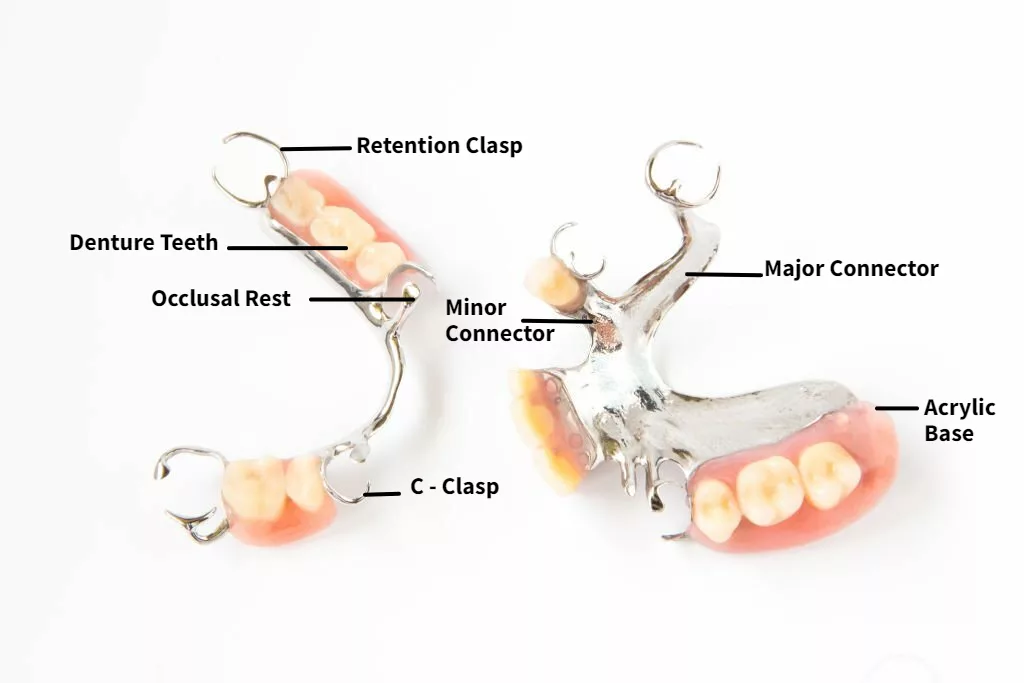
Advantages of Removable Partial Dentures
Enhanced Aesthetics
These dentures maintain facial symmetry and the appearance of the dentition.
Improved Smile
Removable partial dentures contribute to a pleasing smile by covering the edentulous area.
Easy Placement
They are simpler to fit than fixed partial dentures.
Cost-Effective
Removable partial dentures are more budget-friendly than fixed and implant prostheses.
Precise Fit
Their thin material allows for a precise fit to oral structures.
Restored Function
While they may not fully replace implants in restoring tooth function, removable partial dentures aid patients in maintaining functions like chewing a soft diet.
Disadvantages of Removable Partial Dentures
The disadvantages of the Removal Partial Dentures include:
Bone Loss
Removable partial dentures can lead to bone loss over time due to the constant pressure they exert on the underlying oral tissues.7Ozan O, Orhan K, Aksoy S, Icen M, Bilecenoglu B, Sakul BU. The effect of removable partial dentures on alveolar bone resorption: a retrospective study with cone-beam computed tomography. J Prosthodont. 2013 Jan;22(1):42-8. doi: 10.1111/j.1532-849X.2012.00877.x. Epub 2012 Jun 1. PMID: 22672734.
Plaque Accumulation
A removable partial denture is a feasible site for food and plaque accumulation. To avoid this problem, patients should adopt proper denture care routines and dental hygiene measures.
Loss of Retention
Over time, changes in underlying tissue and bone structure will happen, which may cause loose fitting of the denture. The denture will then require a replacement.
Risk of loss
As the patient is reinserting and placing without professional help, there is a great chance of losing or misplacing the denture.
Steps for Removable Partial Dentures
When you visit your dentist for removable partial dentures (RPD), you can anticipate a series of well-defined steps to ensure a precise fit and comfortable structure for your dentures:
Mock-up or Primary Dental Impression
The process begins with creating a detailed dental impression of your mouth to replicate all oral structures accurately.
Dental Impression Sent to Lab
In the dental lab, the technician forms a cast over the impression.
Identifying Supporting and Retentive Components
The dentist identifies which components will serve as the supporting and retentive structures using the dental model. This step also involves determining the appropriate location for clasp placement.
In-Mouth Preparations
The dentist may perform any required preparations in your mouth, such as creating guiding areas and rest seats to support the denture.
Final Impression and Master Cast
Your dentist will take a final impression of your mouth to create a master cast, serving as the foundation for your RPD.
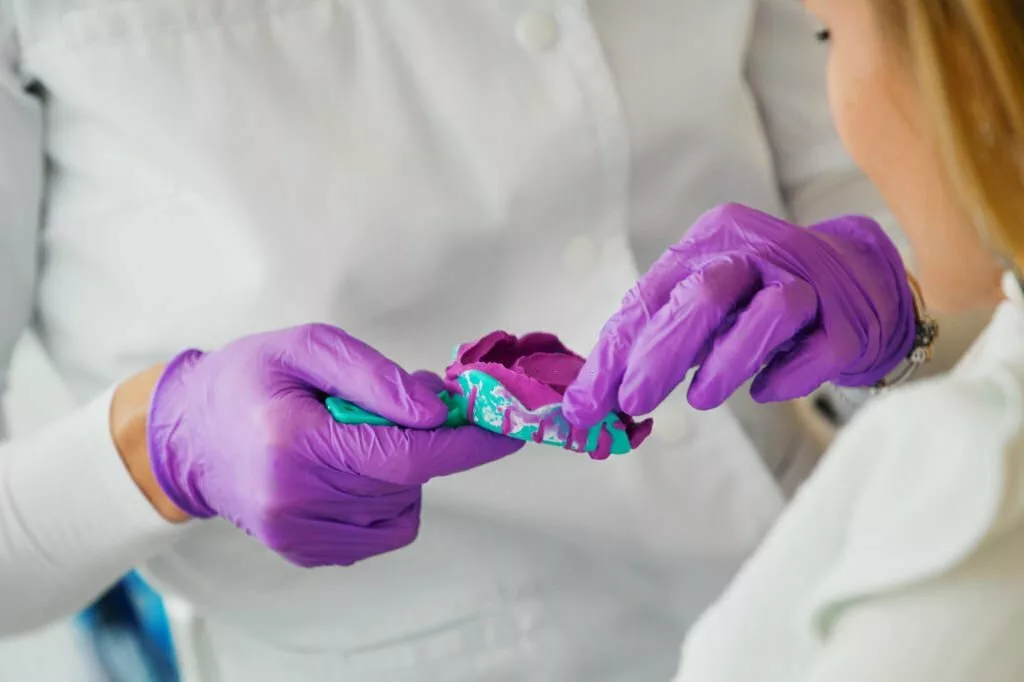
Utilizing Retentive and Blocking Areas
The dentist utilizes the identified retentive areas while blocking any undercuts or hindering areas that could affect the denture’s fit. He then forms a wax pattern on the master cast.
Casting Procedure
The wax pattern is replaced with solid material through a casting procedure, forming the basis of your RPD.
Refinement and Adjustment
The dental team continues to refine and adjust the dentures, ensuring that they align perfectly with your needs. When the final dentures are ready, the Prosthodontist/dentist inserts them in place and checks for comfort and fit.
Post-Treatment Care and Instructions
After inserting the dentures, your dentist will provide you with essential post-treatment care instructions to ensure the continued comfort and effectiveness of your removable partial dentures.
It’s essential to follow your dentist’s guidance for proper care and maintenance of your dentures for the best results. The post-treatment care instructions include the following:
- Give yourself a few days to let your soft tissue get adapted to this new prosthesis.
- Ask your dentist to let you practice inserting and removing dentures in the office setting.
- Take soft diets for two weeks.
- Daily clean your denture with a denture brush, and when removing the denture from the mouth, keep it in water to avoid changes.
- Try to remove the denture at night to relax your soft tissues.
- Clean your gums properly and massage them with your fingers.
- Use a denture cleanser weekly to avoid any microbial accumulation on the denture.
- In case of disturbance in denture fitting, consult your dentist.
- If the denture breaks, don’t try to fix it in the mouth. Visit your dentist for the best repair and replacement options8de Baat, C., Witter, D. J., Keltjens, H. M., & Creugers, N. H. (2011). Periodieke mondonderzoeken en specifieke nazorg bij partiële gebitsprothesen [Routine oral examinations and specific after-care for removable partial dentures]. Nederlands tijdschrift voor tandheelkunde, 118(1), 39–44. https://doi.org/10.5177/ntvt.2011.01.10255
Indications for Removable Partial Dentures
The following are the indications of removable partial dentures:
- Overcome partial tooth loss: It is the best solution for replacements of one or a few missing tooth loss.
- Economical tooth replacement: Compared to fixed alternatives, it is a cost-effective treatment option.
- Tooth movement: RPDs help in preventing the unwanted tooth movements of the teeth adjacent and opposing to the edentulous areas
- Ridge loss: Dentists or prosthodontists usually recommend RPDs in patients with excessive ridge loss.
- Functional restoration enables the patients to speak, chew, and masticate normally.
- Alternative to Fixed Prosthetics: RPDs are used in patients where implants are not feasible due to financial and health constraints9.van Waas M. A. (2009). De indicaties voor een partiële gebitsprothese [Indications for removable partial dentures]. Nederlands tijdschrift voor tandheelkunde, 116(11), 593–596.
Contraindications for Removable Partial Dentures
The following are the contraindications of removable partial dentures:
- Lack of supporting soft tissue and hard tissue in the oral cavity
- Young patients with great aesthetic concerns having ideal implant placement prerequisites
- Patients with poor oral hygiene
- Epileptic patients
Lifespan of Removable Partial Dentures
The life expectancy of a removable partial denture revolves around 5 to 7 years. However, this ideal lifespan requires patients to take meticulous care of dentures. In case of severe bone loss, the life span gets short due to loose fitting of the denture10Vermeulen, A. H., Keltjens, H. M., van’t Hof, M. A., & Kayser, A. F. (1996). Ten-year evaluation of removable partial dentures: survival rates based on retreatment, not wearing and replacement. The Journal of Prosthetic Dentistry, 76(3), 267–272. https://doi.org/10.1016/s0022-3913(96)90170-5.
Complications associated with Removable Partial Dentures
A few complications associated with RPD are:
- Oral ulceration This type of denture can create pressure spots in the body and cause oral ulcers
- Damage to the supporting tooth Continuous clasp placement on the supporting tooth might cause damage to it.
- Bone loss Removable partial dentures can accelerate the bone loss process and hence cause the loose fitting of the denture11Dawid, M. T., Moldovan, O., Rudolph, H., Kuhn, K., & Luthardt, R. G. (2023). Technical Complications of Removable Partial Dentures in the Moderately Reduced Dentition: A Systematic Review. Dentistry journal, 11(2), 55. https://doi.org/10.3390/dj11020055.
Difference Between Removable Partial Denture and Implant
Dentists also use implants to replace missing teeth. However, they place implants inside the bone. They prevent bone loss and give replacements that mimic natural structures. Implants allow the patients to perform all types of functions. Contrary to this, removable dentures offer less aesthetic and functional restoration. However, they are a cost-effective and less invasive option.12Melilli, D., Davì, G., Messina, P., & Scardina, G. A. (2017). Tooth-implant connection in removable denture. Minerva stomatologica, 66(1), 35–42. https://doi.org/10.23736/S0926-4970.16.03953-9. Implants are quite expensive compared to removable partial dentures and require a more surgical procedure for placement into the oral cavity13Gupta, R., Gupta, N., & Weber, DDS, K. K. (2023). Dental Implants. In StatPearls. StatPearls Publishing..
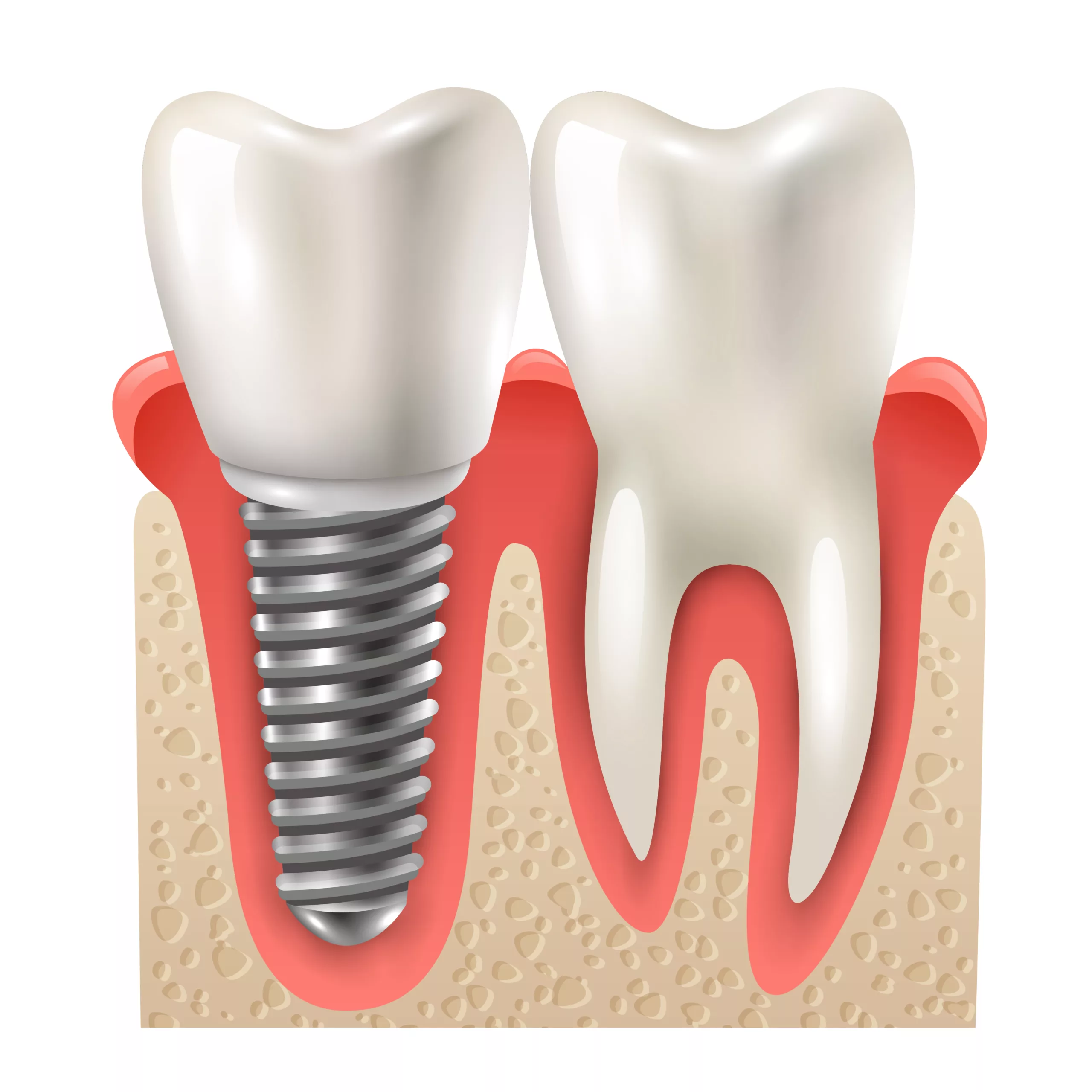
In summary, dentists use removable partial dentures in dentistry to fill the edentulous space. They are easily adaptable and economical and can restore minimal function and appearance of the missing teeth.
Refrences
- 1Campbell, S. D., Cooper, L., Craddock, H., Hyde, T. P., Nattress, B., Pavitt, S. H., & Seymour, D. W. (2017). Removable partial dentures: The clinical need for innovation. The Journal of Prosthetic Dentistry, 118(3), 273–280. https://doi.org/10.1016/j.prosdent.2017.01.008
- 2Davenport, J. C., Basker, R. M., Heath, J. R., Ralph, J. P., & Glantz, P. O. (2000). The removable partial denture equation. British Dental Journal, 189(8), 414–424. https://doi.org/10.1038/sj.bdj.4800787
- 3Craddock HL, Youngson CC, Manogue M, Blance A. Occlusal changes following posterior tooth loss in adults. Part 2. Clinical parameters associated with teeth movement adjacent to the posterior tooth loss site. J Prosthodont. 2007 Nov-Dec;16(6):495-501. doi: 10.1111/j.1532-849X.2007.00223.x. Epub 2007 Aug 2. PMID: 17672834.
- 4Scher E. (1980). ‘Removable partial denture design.’ British Dental Journal, 149(8), 223. https://doi.org/10.1038/sj.bdj.4804496
- 5Jones, J. D., Turkyilmaz, I., & Garcia, L. T. (2010). Removable partial dentures–treatment now and for the future. Texas Dental Journal, 127(4), 365–372.
- 6Walmsley A D. Acrylic partial dentures. Dent Update 2003; 30: 424-429.
- 7Ozan O, Orhan K, Aksoy S, Icen M, Bilecenoglu B, Sakul BU. The effect of removable partial dentures on alveolar bone resorption: a retrospective study with cone-beam computed tomography. J Prosthodont. 2013 Jan;22(1):42-8. doi: 10.1111/j.1532-849X.2012.00877.x. Epub 2012 Jun 1. PMID: 22672734.
- 8de Baat, C., Witter, D. J., Keltjens, H. M., & Creugers, N. H. (2011). Periodieke mondonderzoeken en specifieke nazorg bij partiële gebitsprothesen [Routine oral examinations and specific after-care for removable partial dentures]. Nederlands tijdschrift voor tandheelkunde, 118(1), 39–44. https://doi.org/10.5177/ntvt.2011.01.10255
- 9.van Waas M. A. (2009). De indicaties voor een partiële gebitsprothese [Indications for removable partial dentures]. Nederlands tijdschrift voor tandheelkunde, 116(11), 593–596.
- 10Vermeulen, A. H., Keltjens, H. M., van’t Hof, M. A., & Kayser, A. F. (1996). Ten-year evaluation of removable partial dentures: survival rates based on retreatment, not wearing and replacement. The Journal of Prosthetic Dentistry, 76(3), 267–272. https://doi.org/10.1016/s0022-3913(96)90170-5
- 11Dawid, M. T., Moldovan, O., Rudolph, H., Kuhn, K., & Luthardt, R. G. (2023). Technical Complications of Removable Partial Dentures in the Moderately Reduced Dentition: A Systematic Review. Dentistry journal, 11(2), 55. https://doi.org/10.3390/dj11020055
- 12Melilli, D., Davì, G., Messina, P., & Scardina, G. A. (2017). Tooth-implant connection in removable denture. Minerva stomatologica, 66(1), 35–42. https://doi.org/10.23736/S0926-4970.16.03953-9
- 13Gupta, R., Gupta, N., & Weber, DDS, K. K. (2023). Dental Implants. In StatPearls. StatPearls Publishing.

